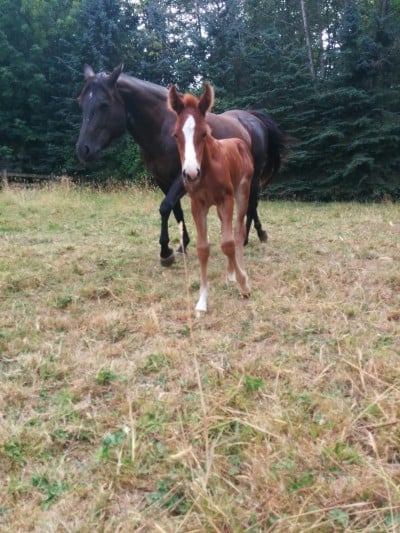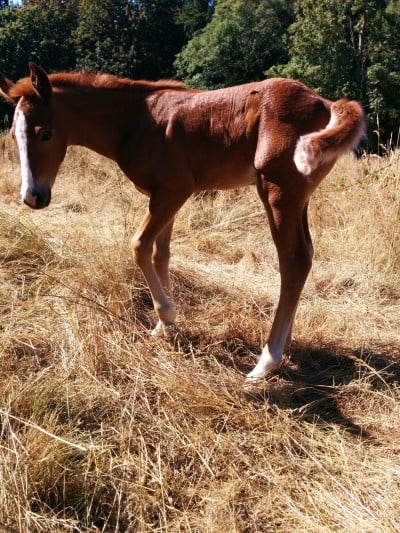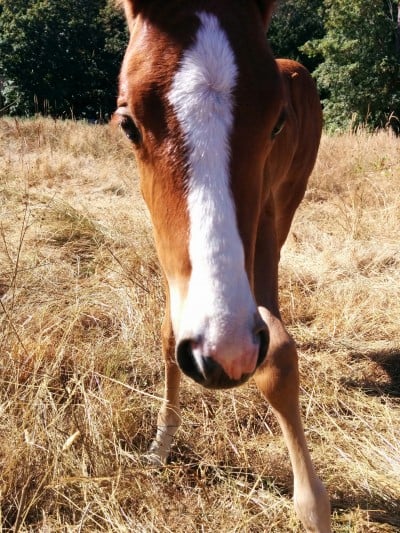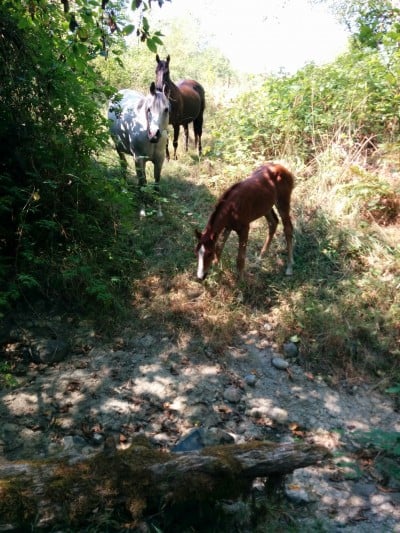Before Firefly, my Mustang/QH filly friend, came into my life, I’d never halter-trained anyone from scratch before. Both my adult horses came into my life with negative associations with the halter (and with other tack), so teaching them that the halter, though admittedly a tool of control and restraint, can ultimately lead to fun excursions and tasty snacks, has greatly informed my work with Baby Firefly. What has surprised me is how quickly and calmly she has accepted the halter, leading work, and cues associated with it, with very little work on my part. Here’s how we’ve done it:
Part 1: The “Off-Leash” Foal
One of my teachers, Chuck Mintzlaff of Friendship Training, has always maintained that the horse should learn everything she needs to know at complete liberty before restrictive equipment is introduced. What a simple concept! No pressure, no fear. Firefly learned to come, follow, turn, back, and stop long before I even bought a halter for her.
Because Fly has grown up in an open environment, never separated from her mother and never forced or coerced by humans, she simply enjoys our two-legged company without fear or stress. If your foal (or grown horse) is fearful of you, the best thing to do is spend quiet, unstructured time with them while they learn that you are only there for friendship.

Fly learned to come and follow in little steps, in close proximity to her mother, who was happy for me to babysit now and then. She wasn’t on solids yet, so the only treat she received was a scratch on her tiny withers – something that absolutely delighted her. Once I realized that she liked to come to me, I simply added verbal and hand cues for her to associate with the action of walking towards me. “Come, Fly!” coupled with a beckoning motion, followed by lots of praise and genuine happiness when she arrived.
Following evolved naturally after that, by me asking her to come, then moving away, asking her to come again, and so on.
From there she learned to turn, without any training, simply because she was following me. I then attached more exaggerated body movements, showing her with my hand and the direction of my gaze that we were about to turn just before we did.


She never had to do what I asked, and she always had her mother, Amalia, to return to any time she needed. As she began following me more confidently, her mother often let us go surprisingly far, and sometimes simply came along for the fun of it. Fly was able to build her confidence naturally and completely at her own pace. I often noticed her returning to her mother after an extended play to nurse, process, and digest what we’d just learned together. Notice how I still haven’t even mentioned the halter yet in this halter-training article! Don’t worry, that’s coming up next in Part 2.

It’s funny writing about it because it really was not planned or executed with any conscious method, we were just exploring together – Jini’s article here on Listen To Your Horse, 5 Minute Fun, captures this collaborative, no-pressure “method” perfectly, by letting unplanned time together evolve into spontaneous games and lessons for both horse and human. This is exactly what I’d been doing – without giving it a name or even calling it “training”.
Having no goals is almost impossible – unless you’re truly in exploration mode, which is so much easier with an adorable baby foal. Working this way with Fly really ignited my awareness and genuine delight in the tiniest things, because I was hyper-aware that this was literally the first time she’d ever considered doing these things and it was so exciting to watch her evolve every day – every hour! I think it’s important to transfer that fascination and excitement to our older horses, and realize that they are opening and exploring and learning as much as we are at every moment.
Next up, Part 2: Introducing the Halter and Lead. We’ll look at how to break down introducing the halter and lead into tiny increments of stress-free learning, all the while keeping it light and fun for both you and the horse.
A barefoot hoof trimmer, a singer/songwriter, an amateur farmer – these are some of the hats Kesia Nagata wears when she’s not full to bursting with wondrous equine co-creation.








omg Fly’s face/neck as you find her sweet spots – and then how she shows you exactly where! Love the way you’ve broken this down.
And for others reading, so far, this is pretty much the same way I’ve trained my 3 semi-feral adult horses to lead. I once looked up and there were a line of people on the lawn staring at me “leading” my stallion around with no halter or rope as we traipsed up and down and criss-crossed the field. They decided I was a “horse whisperer” at that point – but as you can see here, it’s simply body language and relationship, play and curiosity!
The video is private. Can’t view it 🙁
How bizarre – I clicked play and it works just fine for me… Oh wait – you must be trying to watch it on YouTube. Okay I changed the setting from Private to Unlisted so it should work now for you…